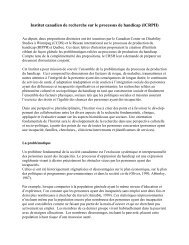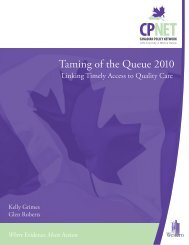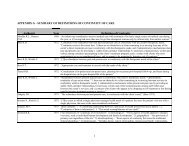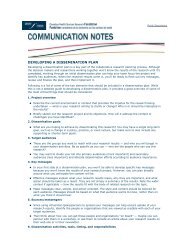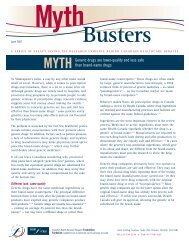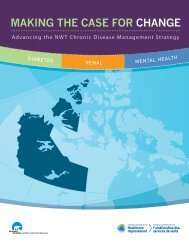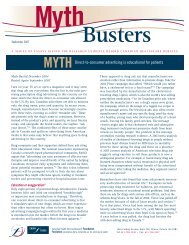Full Report - Fondation canadienne pour l'amélioration des services ...
Full Report - Fondation canadienne pour l'amélioration des services ...
Full Report - Fondation canadienne pour l'amélioration des services ...
You also want an ePaper? Increase the reach of your titles
YUMPU automatically turns print PDFs into web optimized ePapers that Google loves.
The PCPs in the control arm were provided with information about their patients’ ED visits<br />
through a mailed carbonated copy of ED notes which is standard procedure at the ED of SMBD-<br />
JGH. The PCPs in the intervention arm, were notified (through SCS) about their patients’ ED<br />
visits and could get medical information specific to those visits. One week prior to every crossover,<br />
family physicians received a letter advising them when the cross-over would occur. Status<br />
(intervention or control) of PCPs was changed (administrator access level) on the cross-over<br />
date; blinding (control) or permitting (intervention) them to know about their patients’ ED visits.<br />
Sample size determinations<br />
Sample size estimations were based on the expected change in the incidence of return visits to<br />
the ED and ED length of stay (LOS) of patients recruited in the control and intervention arms.<br />
The incidence of return visits within 14 days was estimated at 14% and that of LOS at 9 hours<br />
from JGH statistics. Using a power of 80% and an alpha of 5%, the study would be sensitive to a<br />
minimum absolute difference of 5% in return visits to ED and a 1.8 hours decrease in LOS with<br />
a sample size of 1000 visits per group.<br />
Family physician sampling<br />
Family physicians (FP) whose patients visited the emergency department most frequently were<br />
approached for participation in the study. In all three centres, 70 family physicians were invited<br />
to participate. Although the study could only be done at the JGH, family physicians from the<br />
other two centres had expressed an interest in participating.<br />
The FPs were made aware that their participation would involve the following: a one year<br />
commitment to the study, answering a general questionnaire before and after the study (annex F),<br />
checking their email on a daily basis, having or not access to the SCS intermittently and<br />
responding to an electronic questionnaire for each patient visit to the ED. FPs were equipped<br />
with computers, printers, appropriate software as well as internet hook-up. Access to the web<br />
was made available for them through a telephone line. All family physicians were given a “step<br />
by step” manual (annex G) and had a 2 hour training session by the study coordinator.<br />
11




